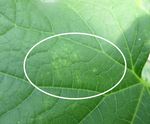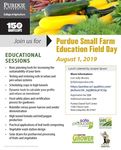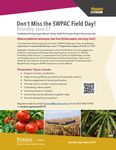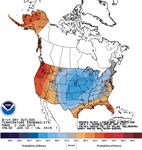Watch for Two-spotted Spider Mites on High Tunnel Cucumbers
←
→
Page content transcription
If your browser does not render page correctly, please read the page content below
Issue: 659
June 7, 2019
As soon as two-spotted spider mites are detected, control efforts
In This Issue need to be taken. In the early stage, yellowish specks on the
Watch for Two-spotted Spider Mites on High Tunnel upper side of the leaves may be noticed (Figure 2). Turn the leaf
Cucumbers over, on the other side of where the yellow specks are, you may
Strawberry Disease Update find the presence of two-spotted spider mites. A 10× hand lens
Indiana Climate Weather Report may be needed to see the pests. Infestations are highest on older
Upcoming Events leaves and at the base of the leaf near the petiole. In severe
cases, two-spotted spider mites cause webbing appearance on
the leaves and lead to leaf defoliation. In hot, dry conditions, mite
Watch for Two-spotted Spider Mites on populations can increase up to 70 times in a week.
High Tunnel Cucumbers
(Wenjing Guan, guan40@purdue.edu, (812) 886-0198) & (Laura Ingwell,
lingwell@purdue.edu, (765) 494-6167)
Supported by NC SARE (LNC17-390), we are continuing research
for improving high tunnel cucumber production.
One of the biggest challenges for growing cucumbers in high
tunnels in the summer is two-spotted spider mites. Dry and hot
environments featured in high tunnels allow two-spotted spider
mite populations to increase rapidly. The mites cause leaf
yellowing, necrosis, and defoliation that interfere with plant
photosynthesis. Yield can be significantly reduced. The pest also
causes direct damage on cucumber fruit, resulting in a
sandpaper-like texture to the rind (Figure 1).
Figure 2. Initial two-spotted spider mite damage on cucumber leaves.
Almost all the high tunnel cucumber cultivars are susceptible to
two-spotted spider mite damage. Nevertheless, we noticed that
Japanese cucumber cultivars such as Taurus seem to be more
tolerant of two-spotted spider mite damage.
Figure 1. Two-spotted spider mite damage on cucumber fruit.
Early detection is the key for controlling two-spotted spider mites. Figure 3. Taurus was grown in the front, Corinto was grown in the back.
1Several miticides are labeled for controlling two-spotted spider
mites, however, they are not always allowed for greenhouse and
high tunnel use on cucumbers. Frequent harvest interval of
cucumbers also limits the use of some synthetic miticides.
Miticides that can be used on high tunnel cucumbers and have
relatively shorter preharvest intervals include Acramite®, Shuttle®
O, Kanemite® etc.
Insecticide soap such as M-Pede® is commonly used to manage
two-spotted spider mites in organic production. It has no residual
control, so good coverage and frequent application are important
to suppress pest populations. Automated water mixing systems
that wet plant leaves frequently may be used to suppress the
pest population.
Biological control with predatory mites is successfully used in
greenhouse cucumber production. Multiple species of predatory
mites are commercially available, and their efficiency may differ
according to pest populations, temperature, humidity conditions,
and cultural practices. Multiple releases may be required for Figure 1. Leaf spot lesions on strawberry often have purple margins and a
gray center.
effective control. For high tunnel production, currently, there is
little information on the efficacy and economic feasibility of using There are several cultural methods of managing leaf spot. Host
predatory mites to control two-spotted spider mites. resistance or incomplete resistance to leaf spot exists in several
strawberry varieties. Since leaf wetness is necessary to initiate
leaf spot, avoid overhead irrigation and plant strawberries at the
proper spacing so that there is plenty of airflow between plants
Strawberry Disease Update and rows. If annual culture is used, crop rotation will help to
(Dan Egel, egel@purdue.edu, (812) 886-0198)
lessen the severity of this disease. Fungicides may not be
At the Southwest Purdue Ag Center, we are studying annual necessary for management; however, several fungicides are
strawberry production on plastic mulch. Our hope is to gather listed in the Midwest Fruit Pest Management Guide 2019-2020.
information on the best methods and varieties to use for annual
Botrytis fruit rot/gray mold-Whereas leaf spot affects fruit only
strawberry production in Indiana. As we learn about insect and
indirectly, Botrytis fruit rot affects fruit directly. Symptoms include
disease problems, we will pass this information on to producers.
the rot of fruit and the production of a gray mold over the surface
This article is about the diseases we have observed in our
of the fruit (Figure 2). Blossoms may also be affected.
strawberries which were planted in March 2019.
Strawberry leaf spot-Lesions on leaves start out purple. As the
lesions enlarge, the center becomes gray-brown (Figure 1). Under
rainy conditions, lesions may coalesce across leaves and cause
large necrotic areas. Lesions on stems and petioles may cause
dieback. Yield or fruit quality loss can be caused by leaf spot
under severe conditions. Although leaf spot symptoms are spread
throughout our trial, this disease has not become serious for us.
Figure 2. Strawberry fruit or gray mold causes a rot of the fruit often with the
appearance of gray mold.
Gray mold is favored by rain fall and high humidity. In fact, we
have observed this disease in high tunnel situations where there
is no rainfall. Since gray mold can affect many different crops,
crop rotation may not be very effective for this disease. Although
there are no resistant varieties, cultivars with an upright growth
habit may be less severely affected. Plants spaced adequately will
have better airflow and less humid conditions. There are a few
fungicides listed in the Midwest Fruit Pest Management Guide,
2however, the most critical time for control is during bloom. state was above normal. Northwestern Indiana was 3.41” above
Sanitation, that is proper disposal of old leaves and fruit, is more normal and southeastern Indiana was 0.18” above normal for the
important for perennial strawberry production than for annual month (Figure 1). Temperatures were near normal in the northern
production. and above normal in the central and southern tiers of the state.
Anthracnose-This disease is the most serious disease problem Some stations in Central Indiana recorded rainfall on 24 out of 31
we have faced this year. The most common symptom is sunken days.
lesions on fruit (Figure 3). Occasionally, the lesions can cover a
significant portion of the fruit. The lesions can be a pink or salmon
color during wet conditions due to the color of the spores. Under
severe conditions, lesions can occur on the stem or crowns.
However, in our trials, we have only observed fruit symptoms.
Figure 1. Indiana Precipitation – Departure from Mean May 2019
The good news is that many areas saw dry conditions set in the
last week of May and beginning of June and helped alleviate some
of the saturated soils. This actually provided a very limited
Figure 3. Anthracnose of strawberry causes sunken lesions. window of opportunity for the agriculture industry. Unfortunately,
the weather looks to turn off wet again with 1 to 4 inches of
Warm, wet weather favors this disease; rain can splash the spores
rainfall projected through June 10th. The wet pattern looks to
from plant to plant. Therefore, avoid overhead irrigation. The
fungus that causes anthracnose of strawberry is related to but continue through the first three weeks of June with higher
different from the anthracnose fungi that cause anthracnose of, confidence in below normal temperatures and above normal
for example, tomato or watermelon; crop rotation will help to precipitation (Figure 2 & 3).
lessen disease symptoms. Planting materials may harbor the
disease, fungicides for control of anthracnose may be applied
through pre-plant dip or foliar application. Several fungicides are
listed in the Midwest Fruit Pest Management Guide.
The Midwest Fruit Pest Management Guide noted earlier has
many resources. Note that there is a table for cultivar resistance
on page 118 (information for leaf spot varieties are listed) and a
table for fungicide effectiveness on page 119. When selecting
products, be sure to keep track of which products are
recommended pre-bloom, post-bloom and harvest. Once harvest
has started, note preharvest intervals.
Strawberry production can be a profitable venture. Keeping track
of disease will help to maintain yields and fruit quality.
Indiana Climate Weather Report
(Austin Pearson, pearsona@purdue.edu, (765) 675-1177)
As we close the doors on May for the year, one of the biggest Figure 2. 8-14 Day Temperature Outlook
stories throughout the month was the precipitation. The entire
3Southwest Purdue Agricultural Center Field Day
Date: June 27, 2019. Registration begins at 8:30 am.
Location: Southwest Purdue Agricultural Center, 4669 N. Purdue
Road in Vincennes, IN 47591
Topics related to vegetable production include:
Organic Tomato Production: Dan Egel will discuss the
Tomato Organic Management and Improvement Project
— including foliar disease management of tomatoes.
High Tunnel Grafted Cucumber & Specialty Melon
Production: Wenjing Guan and Petrus Langenhoven will
discuss cucumber and melon production in high tunnels.
Applying IPM Principles across Cropping Systems to
Increase Insect Pollination and Profitability: Laura
Ingwell will discuss best management practices for
watermelon production by quantifying pest pressures,
pollinator health, and crop yields.
Figure 3. 8-14 Day Precipitation Outlook Annual Strawberry Production: Wenjing Guan will
discuss annual plastic culture for strawberry production in
Taking this forecast into consideration, it is extremely important
southern Indiana.
to keep an eye on vegetation as conditions may be favorable for
disease development. Purdue Extension has various publications Other topics include:
about disease management that may be utilized to assist with
Termites to the Rescue: In this presentation, Rick
various diseases.
Meilan will discuss the use of enzymes derived from
termites to control invasive woody species.
Removing Invasive and Cultivating Natives: Join Will
Upcoming Events Drews to see SWPAC’s work to remove invasive plants
Indiana Horticultural Society Summer Meeting around the property and create a native pollinator habitat.
Growing Hemp in Indiana: Chuck Mansfield and Valerie
Date: June 25, 2019. 9:30 am.
Clingerman will offer an update on the use of this versatile
Location: Huber Orchard and Winery, 19816 Huber Road, plant — grown for its fiber, seed, or oil — across the state.
Starlight, IN 47106 Eyes in the Sky…Decisions on the Ground: Bob
The summer meeting is co-sponsored by Indiana Horticultural Nielsen discusses the benefit of aerial “reconnaissance”
Society and Indiana Vegetable Growers’ Association. The meeting via unmanned aerial drones to scout crop problems or
will focus on commercial production of fruits and vegetables and augment data.
farm marketing. All those interested are welcome to attend.
A meal will be included, and PARP classes also will be available
A registration fee of $5.00 per family or farm is payable at after lunch. To register, email joynerb@purdue.edu, call (812)
registration. A catered lunch will be served onsite. This will most 886-0198, or go online at
likely be fried chicken with vegetables and drinks. There is a https://purdue.ca1.qualtrics.com/jfe/form/SV_8pnF8z1CwyglrGl by
$10/person charge for lunch, collected onsite. Please go to the Monday, June 17.
following website to RSVP
https://purdue.ca1.qualtrics.com/jfe/form/SV_6oqUlioijOUNb0x
9:30 am Convene and registration at Huber Orchard and
Winery.
10:00 am Introductions, a brief walking tour of facilities – winery,
market, icecream store, banquet hall
10:30 am Field tour – apples
11:45 pm Lunch – $10 – RSVP requested (see below)
1:00 pm Field tours – peaches, vegetables, small fruit
4:00 pm Wrap up and conclude (Optional winery and distillery
tour for those interested)
4Small Farm Education Field Day at Purdue Student Farm
Date: August 1, 2019
Location: Purdue Student Farm, West Lafayette, IN 47907
The Purdue Student Farm is proud to announce its second annual
Small Farm Education Field Day. The event is packed with
educational sessions during the morning, followed by a tour and
hands-on experiences on the farm. Topics of discussion
throughout the day include basic planning tools for a sustainable
small farm operation, testing and restoring soils in urban and peri-
urban systems, scheduling crops in high tunnels, using different
cover crops to build your soil, calculating profits and return on
investment using enterprise budgets and food safety plants for
small growers and gardeners. During the afternoon there will be a
rototiller versus power harrow, high tunnel tomato and sweet
pepper production, leaf mold composting, vegetable wash station
design, and solar dryer demonstrations.
Registration fee is $20.
Meigs High Tunnel Field Day
Register here
Date: July 18, 2019
https://purdue.ca1.qualtrics.com/jfe/form/SV_3qQfl05iryF3COp
Location: Purdue Meigs Farm, 9101 S 100E, Lafayette, IN 47909
Registration closes July 29, 2019.
Topics of the field day include Production of specialty melons in
high tunnels; Early detection of bacterial wilt; Impact of crop
rotation and rootstock on the resilience of high tunnel tomatoes.
Lunch and refreshments are provided. Registration is free, but
required.
Register here
https://purdue.ca1.qualtrics.com/jfe/form/SV_0HXQwDluRiOnwAB
For questions please contact Lori Jolly-Brown at
ljollybr@purdue.edu or 765-494-1296
It is the policy of the Purdue University that all persons have equal opportunity and access to its educational programs, services, activities, and facilities without regard to race, religion, color, sex, age,
national origin or ancestry, marital status, parental status, sexual orientation, disability or status as a veteran. Purdue is an Affirmative Action Institution. This material may be available in alternative
formats. 1-888-EXT-INFO Disclaimer: Reference to products in this publication is not intended to be an endorsement to the exclusion of others which may have similar uses. Any person using products
listed in this publication assumes full responsibility for their use in accordance with current directions of the manufacturer.
5Vegetable Crops Hotline © Purdue University - vegcropshotline.org
Editor: Wenjing Guan | Department of Horticulture and Landscape Architecture, 625 Agriculture Mall Dr., West Lafayette, IN 47907 |
(812) 886-0198
6You can also read



























































